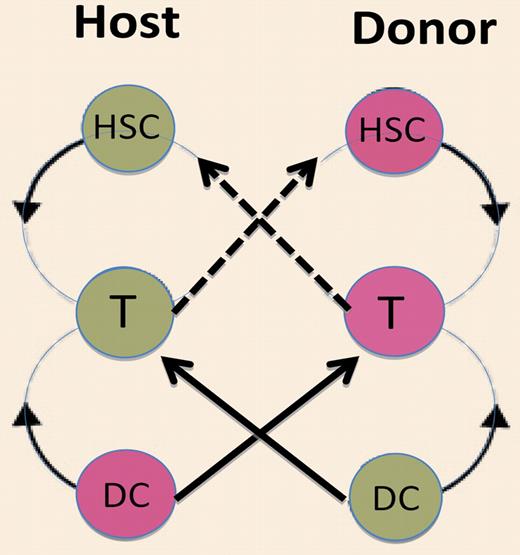In this issue of Blood, Taylor and colleagues studied the effect of CpG oligonucleotide ligands for TLR9 on host and donor APCs in a murine model of allogeneic bone marrow transplantion. The article describes an unexpected result: administration of CpG activated both donor and host DCs, resulting in enhanced rates of graft rejection and accelerated GVHD.
The current paradigm for understanding engraftment in allogeneic hematopoietic progenitor cell transplantation is that donor T cells facilitate engraftment by donor stem cells, host dendritic cells (DCs) activate donor T cells and induce graft versus host disease (GVHD), and host T cells mediate graft rejection.1,2 The role for donor DCs has been neglected due, in part, to their scarcity in bone marrow grafts, assumptions of limited survival in allogeneic recipients after transplantation, and the overwhelming larger numbers of host DCs that are capable of directly presenting alloantigen to donor T cells. A novel finding in the report by Taylor et al relates to a role for donor DCs in modulating engraftment. The study is also of some interest to transplant immunologists, since it suggests caution in using nonspecific immune adjuvants due to the increased risks of deleterious host-initiated and donor-initiated innate and adaptive immune responses. Administration of CpC oligonucleotides resulted in increased infiltration of lymphoid organs and Peyer patches by donor T cells in allogeneic recipients. The augmented alloreactivity was made manifest as increased GVHD and graft rejection, with the donor and host T cells activated by host-type and donor-type antigen-presenting cells (APCs), respectively, following toll-like receptor 9 (TLR9) ligand binding to APCs. Accelerated GVHD (but not graft rejection) was dependent on IFN-γ synthesis by T cells. Of note, bone marrow from donor mice deficient in CD80 or CD86 costimulatory molecules engrafted more efficiently after recipients received sublethal irradiation, supporting the role for donor APCs in activating host immunity and effector T cells that mediate graft rejection.
Adaptation of a Scottish country dance reel substituting dance partners with the cell types involved in allogeneic transplantation. Green indicates host; and pink, donor. Dashed line represents cell killing; and solid line, differentiation or stimulation.
Adaptation of a Scottish country dance reel substituting dance partners with the cell types involved in allogeneic transplantation. Green indicates host; and pink, donor. Dashed line represents cell killing; and solid line, differentiation or stimulation.
The paper by Taylor et al represents part of an emerging paradigm that runs counter to existing dogma regarding the importance of host DCs rather than donor DCs in allogeneic transplantation. This report represents the first clear demonstration of an important effect of donor DCs, contained in the graft, in the regulation of host immune activation. Complementary studies from our own group have demonstrated a role for donor DCs in augmenting the alloreactivity of donor T cells and enhancing graft versus leukemia effects.3,4 Thus, it is time for donor DCs to take their turn in the dance of cell types involved in allogeneic transplantation. These donor cell populations are excellent targets for novel maneuvers in graft engineering designed to reduce graft rejection by reducing host T-cell activation or augment donor T-cell alloreactivity to increase graft versus leukemia effects.
Conflict-of-interest disclosure: The authors declare no competing financial interests. ■

